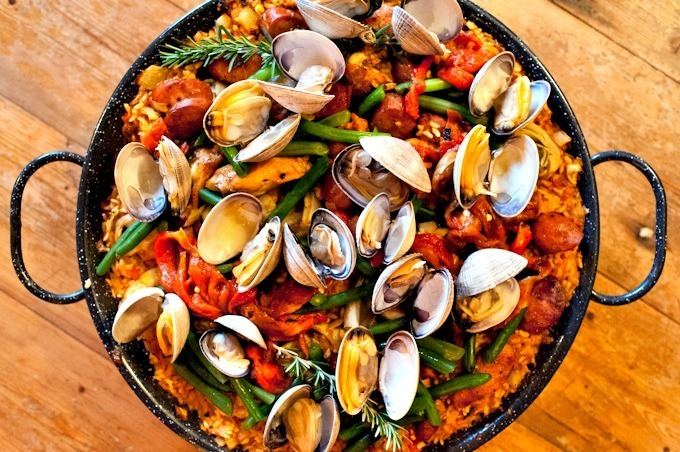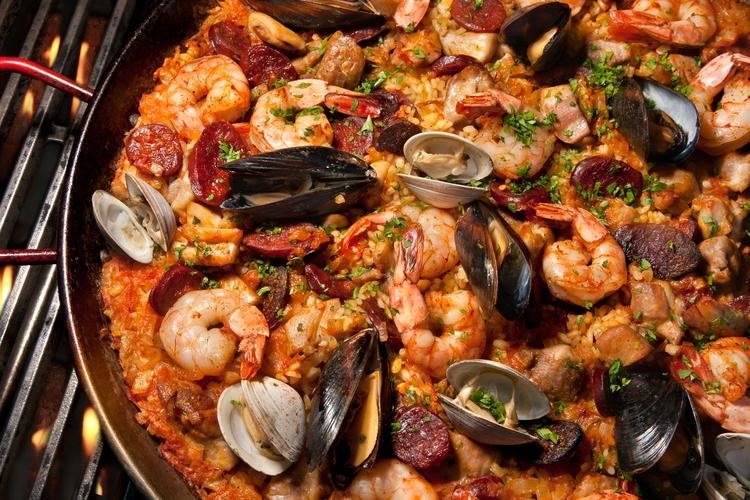Course Main course Serving temperature Hot | Region or state Valencia Place of origin Spain | |
 | ||
Main ingredients White rice, chicken, rabbit, duck, vegetables Other information Popular throughout:
Worldwide Similar Tapas, Risotto, Chorizo, Gazpacho, Saffron | ||
How to make spanish paella omar allibhoy
Paella ([paˈeʎa] or [pəˈeʎə], [paˈeʎa]; English approximation: /pɑːˈeɪlə, -ˈeɪljə, -ˈeɪjə, -ˈɛlə, -ˈjɛlə/ or /paɪˈɛlə/) is a Valencian rice dish. Paella has ancient roots, but its modern form originated in the mid-19th century near the Albufera lagoon on the east coast of Spain adjacent to the city of Valencia. Many non-Spaniards view paella as Spain's national dish, but most Spaniards consider it to be a regional Valencian dish. Valencians, in turn, regard paella as one of their identifying symbols.
Contents
- How to make spanish paella omar allibhoy
- Paella recipe how to make paella seafood paella
- Etymology
- Possible origins
- Valencian paella
- Seafood and mixed paella
- Basic cooking methods
- Seafood paella
- Mixed paella
- For all recipes
- Competitions and records
- Controversy
- Similar dishes
- In popular culture
- References

Types of paella include Valencian paella, vegetarian/vegan paella (Spanish: paella de verduras), seafood paella (Spanish: paella de marisco), and mixed paella (Spanish: paella mixta), among many others. Valencian paella is believed to be the original recipe and consists of white rice, green beans (bajoqueta and tavella), meat (chicken and rabbit), white beans (garrofón), snails, and seasoning such as saffron and rosemary. Another very common but seasonal ingredient is artichokes. Seafood paella replaces meat with seafood and omits beans and green vegetables. Mixed paella is a free-style combination of meat from land animals, seafood, vegetables, and sometimes beans. Most paella chefs use bomba rice due to it being less likely to overcook, but Valencians tend to use a slightly stickier (and thus more susceptible to overcooking) variety known as Senia. All types of paellas use olive oil.

Paella recipe how to make paella seafood paella
Etymology

Paella is a word in Valencian which derives from the Old French word paelle for pan, which in turn comes from the Latin word patella for pan.

The word paella is also related to paila used in many Latin American countries. Paila in the Spanish language of Latin America refers to a variety of cookware resembling metal and clay pans, which are also used for both cooking and serving.

The Latin root patella from which paella derives is also akin to the modern French poêle, the Italian padella and the Old Spanish padilla.

Valencians use the word paella for all pans in the Valencian language, including the specialized shallow pan used for cooking paellas. However, in most other parts of Spain and throughout Hispanic America where the Spanish language is spoken (as opposed to the Valencian language), the term paellera ("maker of paella") is more commonly used for the specialised pan while paella is reserved for the rice dish prepared in it, although both terms are deemed correct for the pan, as stated by the Royal Spanish Academy, the body responsible for regulating the Spanish language in Spain. Paelleras are traditionally round, shallow, and made of polished steel with two handles.
Possible origins
Moors in Muslim Spain began rice cultivation around the 10th century. Consequently, Valencians often made casseroles of rice, fish, and spices for family gatherings and religious feasts, thus establishing the custom of eating rice in Spain. This led to rice becoming a staple by the 15th century. Afterwards, it became customary for cooks to combine rice with vegetables, beans, and dry cod, providing an acceptable meal for Lent. Along Spain's eastern coast, rice was predominantly eaten with fish.
Spanish food historian Lourdes March notes that the dish "symbolizes the union and heritage of two important cultures, the Roman, which gives us the utensil and the Arab which brought us the basic food of humanity for centuries."
Valencian paella
On special occasions, 18th century Valencians used calderos to cook rice in the open air of their orchards near lake Albufera. Water vole meat was one of the main ingredients of early paellas, along with eel and butter beans. Novelist Vicente Blasco Ibáñez described the Valencian custom of eating water voles in Cañas y Barro (1902), a realistic novel about life among the fishermen and peasants near lake Albufera.
Living standards rose with the sociological changes of the late 19th century in Spain, giving rise to gatherings and outings in the countryside. This led to a change in paella's ingredients, as well, using instead rabbit, chicken, duck and sometimes snails. This dish became so popular that in 1840, a local Spanish newspaper first used the word paella to refer to the recipe rather than the pan.
The most widely used, complete ingredient list of this era was: short-grain white rice, chicken, rabbit, snails (optional), duck (optional), butter beans, great northern beans, runner beans, artichoke (a substitute for runner beans in the winter), tomatoes, fresh rosemary, sweet paprika, saffron, garlic (optional), salt, olive oil, and water. Poorer Valencians, however, sometimes used nothing more than snails for meat. Valencians insist that only these ingredients should go into making modern Valencian paella.
Seafood and mixed paella
On the Mediterranean coast, Valencians used seafood instead of meat and beans to make paella. Valencians regard this recipe as authentic, as well. In this recipe, the seafood is served in the shell. A variant on this is paella del senyoret which uses seafood without shells. Later, however, Spaniards living outside of Valencia combined seafood with meat from land animals and mixed paella was born. This paella is sometimes called preparación barroca (baroque preparation) due to the variety of ingredients and its final presentation.
During the 20th century, paella's popularity spread past Spain's borders. As other cultures set out to make paella, the dish invariably acquired regional influences. Consequently, paella recipes went from being relatively simple to including a wide variety of seafood, meat, sausage (including chorizo), vegetables and many different seasonings. However, the most globally popular recipe is seafood paella.
Throughout non-Valencian Spain, mixed paella is very popular. Some restaurants in Spain (and many in the United States) that serve this mixed version refer to it as Valencian paella. However, Valencians insist that only the original two Valencian recipes are authentic, and generally view all others as inferior, not genuine, or even grotesque.
Basic cooking methods
According to tradition in Valencia, paella is cooked over an open fire, fueled by orange and pine branches along with pine cones. This produces an aromatic smoke which infuses the paella. Also, dinner guests traditionally eat directly out of the paellera.
Some recipes call for paella to be covered and left to settle for five to ten minutes after cooking.
Valencian paella
This recipe is standardized because Valencians consider it traditional and very much part of their culture. Rice in Valencian paella is never braised in oil, as pilaf, though the paella made further southwest of Valencia often is.
Seafood paella
Recipes for this dish vary somewhat, even in Valencia. The recipe below is based on the two cited here.
Mixed paella
There are countless mixed paella recipes. The following method is common to most of these. Seasoning depends greatly on individual preferences and regional influences. However, salt, saffron and garlic are almost always included.
For all recipes
After cooking paella, there is usually a layer of toasted rice at the bottom of the pan, called socarrat in Spain. This is considered a delicacy among Spaniards and is essential to a good paella. The toasted rice develops on its own if the paella is cooked over a burner or open fire. If cooked in an oven, however, it will not. To correct this, place the paellera over a high flame while listening to the rice toast at the bottom of the pan. Once the aroma of toasted rice wafts upwards, it is removed from the heat. The paella must then sit for about five minutes (most recipes recommend the paella be covered with a tea-towel at this point) to absorb the remaining broth.
Competitions and records
It has become a custom at mass gatherings in the Valencian Community (festivals, political campaigns, protests, etc.) to prepare enormous paellas, sometimes to win mention in the Guinness Book of World Records. Chefs use gargantuan paelleras for these events.
Valencian restaurateur Juan Galbis claims to have made the world's largest paella with help from a team of workers on 2 October 2001. This paella fed about 110,000 people according to Galbis' former website. Galbis says this paella was even larger than his earlier world-record paella made on 8 March 1992 which fed about 100,000 people. Galbis's record-breaking 1992 paella is listed in Guinness World Records.
Controversy
Many chefs around the world have taken the traditional dish and added ingredients that are considered not to belong in the dish by Valencians. Spaniards, especially people from Valencia, have complained about this many times and it is a recurrent topic online. The alternative name proposed for these dishes, although pejorative, is "Arroz con cosas" (rice with things). Famous cases are Jamie Oliver's paella recipe and Gordon Ramsay. The author Josep Pla once noted:
The abuses committed in the name of Paella Valenciana, are excessive - an absolute scandal.
Similar dishes
Traditional Valencian cuisine offers recipes similar to paella valenciana and paella de marisco such as arròs negre, arròs al forn, arròs a banda and arròs amb fesols i naps. Fideuà is a noodle dish variation of the paella cooked in a similar fashion, though it may be served with allioli sauce.
The following is a list of other similar rice dishes:
In popular culture
In 2015, an emoji for paella was proposed to Unicode. The emoji was approved for Unicode 9.0 as U+1F958 "SHALLOW PAN OF FOOD" in June 2016. Although it is generally rendered as paella, Samsung has realized the symbol as a Korean hot pot.
